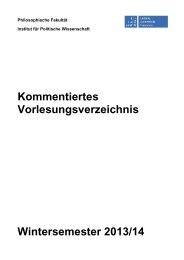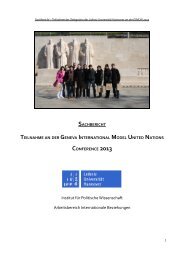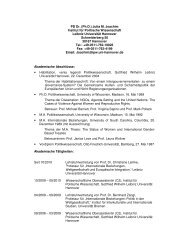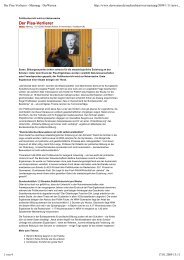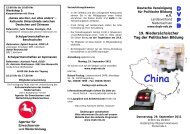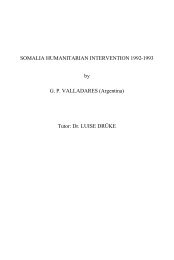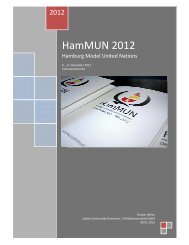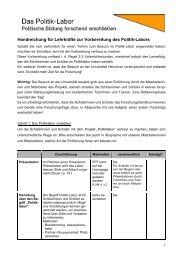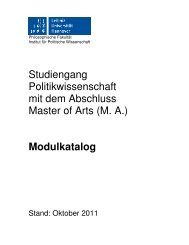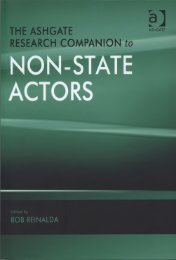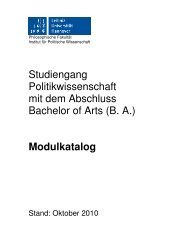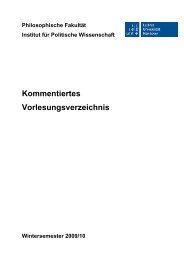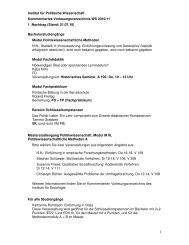Preventive Action for Refugee Producing Situations
Preventive Action for Refugee Producing Situations
Preventive Action for Refugee Producing Situations
You also want an ePaper? Increase the reach of your titles
YUMPU automatically turns print PDFs into web optimized ePapers that Google loves.
106 Chapter 3<br />
other than the USA, might have been able to apply pressure on Vietnam<br />
to ease its re-education policies and to make its new economic policies<br />
more flexible at a much earlier stage. Threats by those Western countries<br />
who maintained small aid programs, despite the USA-advocated embargo<br />
since 1979, to cut funding <strong>for</strong> food and development aid, reconstruction<br />
assistance, and aid to internally displaced people, might have produced<br />
some liberalization in the conditions that compelled people to flee.<br />
Even though the so-called "Paris Cease Fire Agreement" of 1973, prior<br />
to the US withdrawal, predicted that the United States would contribute to<br />
the healing of the war in post war reconstruction of the democratic<br />
Republic of Vietnam and throughout Indochina no specific agreement had<br />
been made in this regard. 234 Vietnam's request <strong>for</strong> U.S. reparation<br />
payments <strong>for</strong> war destruction has long been a barrier to reestablishing<br />
U.S. - Vietnamese relations, even though the issue was discussed during<br />
the Nixon administration.<br />
I believe, along with other in<strong>for</strong>med analysts of the scene, 235 that if<br />
both sides had been able to make some reasonable concessions, a number<br />
of developments might have been possible, including a more reasonable<br />
treatment of South Vietnamese dissenters; a somewhat balanced approach<br />
in international relations, with less reliance on the USSR; probably a more<br />
peaceful, less aggressively militaristic attitude, perhaps avoiding an<br />
invasion into Cambodia; and more opportunities inside the country,<br />
producing fewer refugees.<br />
Analytical Discussion 107<br />
3.1.2.2. Nicaraguan <strong>Refugee</strong>s in Honduras and CIREFCA<br />
Introduction<br />
The massive displacements of Miskito and Sumo Indians within Nicaragua<br />
and into Honduras are a sobering example of how indigenous people can be<br />
manipulated into becoming casualties of power politics. It is not the number<br />
of refugees involved in this case that is noteworthy, but rather the strategies<br />
practiced upon them by external <strong>for</strong>ces. A full analysis of the complex<br />
motives leading to the displacement of the Miskitos and Sumos is beyond<br />
the scope of this dissertation; in this section we will concentrate on the<br />
conditions that led to the movements into Honduras in the spring of 1986.<br />
This study will focus on the persons <strong>for</strong> whom the UNHCR attempted<br />
to provided international protection and assistance. It will not attempt to<br />
provide a full analysis of the underlying political ambitions and actions of<br />
the indigenous anti-governmental <strong>for</strong>ces that operated in Nicaragua and<br />
Honduras on both sides of the Coco River. It will, however, attempt to<br />
pinpoint the direct impact of the rebels' actions on the indigenous peoples of<br />
the region, many of whom were made refugees against their will, often<br />
repeatedly, were prevented from returning home voluntarily, and feared or<br />
suffered <strong>for</strong>ced recruitment. The data <strong>for</strong> this investigation are drawn from<br />
primary and secondary printed sources and from interviews with selected<br />
policymakers, UNHCR colleagues and non-United Nations officials during<br />
and after my term of service as the United Nations and non-United Nations<br />
officials. Another important source of in<strong>for</strong>mation is the personal interviews<br />
I conducted with 808 Misquito Indians in refugee locations in Honduras in<br />
February 1986. The International Conference on <strong>Refugee</strong>s in Central<br />
America (CIREFCA) has been documented elsewhere.<br />
Background<br />
The Atlantic Coast, or 5 "Mosquitia," of both Nicaragua and Honduras is<br />
marked by ethnic, geographic, and political complexity. An estimated ten<br />
percent of Nicaragua's population is Indian, including about 75,000 Miskitos<br />
and a small, shrinking group of some 5000 Sumos. 236 In addition, there<br />
are small groups of Rama Indians, another Amerindian group, now<br />
__________________________<br />
234 Agreement on Ending the War and Restoring Peace in Vietnam, 27 January<br />
1973, Article 21.<br />
235 Dyer/Claik, "Vietnamese Boat People Crisis," p. 19.<br />
______________________<br />
236 <strong>Refugee</strong>s, UNHCR Geneva, August 1987, p. 28.



